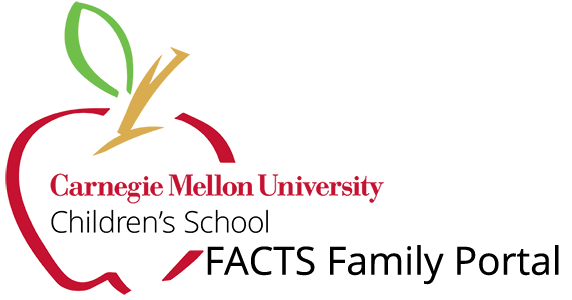October 2023: Building Self-Esteem & Independence
The Children’s School’s educational philosophy is based on theories and research in Developmental Psychology. We use “developmental goals” as a systematic framework for focusing our program design. Beginning with this newsletter, I will highlight one set of goals each month to make the rationale underlying our design decisions clearer, as well as to support families in fostering their children’s development with similar intentionality.
Self-Esteem & Independence: encouraging each child's growing self-concept and confidence, as well as increasingly independent self-regulation and self-care.
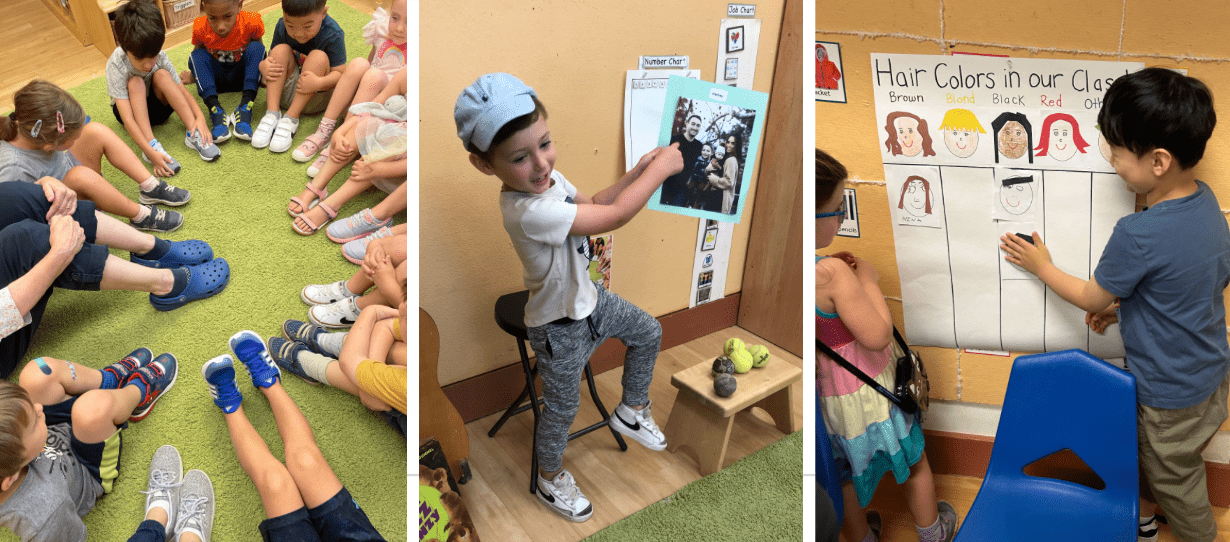
Psychologist Erik Erikson emphasized young children’s need to develop a sense of autonomy, the confidence to take initiative, and the motivation to industriously master culturally valued tasks. Jean Piaget highlighted children’s innate disposition to explore the world as curious scientists. In both theories, the role of adults is simply to provide a safe and encouraging environment for exploration. At the Children’s School, we view this developing self-esteem and independence as foundational for all children’s other achievements. We let children know that they are special and that they belong by using their names and photographs throughout the classrooms, by displaying the products of their efforts, and by inviting them to contribute meaningfully to the group. By learning to value and manage themselves, including their bodies, their actions, and their emotions, children acquire a positive and proactive stance toward learning to interact, to communicate, and so on.
Within each theme, educators highlight each child’s uniqueness in a variety of ways. In September, we encourage children to share their families and experiences with each other, while also teaching them to follow the rules and routines that keep everyone safe, comfortable, and engaged. Other units, such as Music & Musicians, Storytelling, or Art & Color, invite children to share their preferences and create based on their own ideas, while building skills for varied expressive media. Studying themes related to our own region, such as the Preschool 3’s upcoming Harvest unit, the Preschool 4’s upcoming Pittsburgh unit, and the PreK/Kindergarten’s upcoming Biomes of the World unit, provide opportunities for children to share their personal experiences in the community and through travel.
The beginning of the school year naturally provides many chances for children to practice taking care of themselves, their belongings, and the school materials, all while managing their emotions and bodies within a group of peers. Practice with new tools for drawing, cutting, gluing, eating, cooking, and building is both challenging and satisfying as skills grow. In all these ways, children begin to view themselves as capable individuals with a “can do” approach to new situations.
Families can promote self-esteem and independence by allowing time and providing encouragement for children to master a wide variety of self-help skills, such as feeding, dressing, and bathing themselves, as well as taking care of their belongings. Finding age-appropriate ways for each child to contribute to the household work helps children to understand their value to the family and to feel confident offering help elsewhere. You’d be amazed at what children can do when given clear training and plenty of practice. Their satisfaction in accomplishment is a joy to witness!

November 2023: Fostering Interaction & Cooperation
The Children’s School’s “developmental goals” for interaction and cooperation provide a systematic framework for design details in all aspects of our early childhood programs. To clarify the intentionality of our design decisions, as well as to support families in fostering their children’s development, I will share the theories underlying our philosophy and their implications for our approaches.
Interaction & Cooperation - promoting children's social skills for effective adjustment to school, group participation, classroom citizenship, and peer interactions.
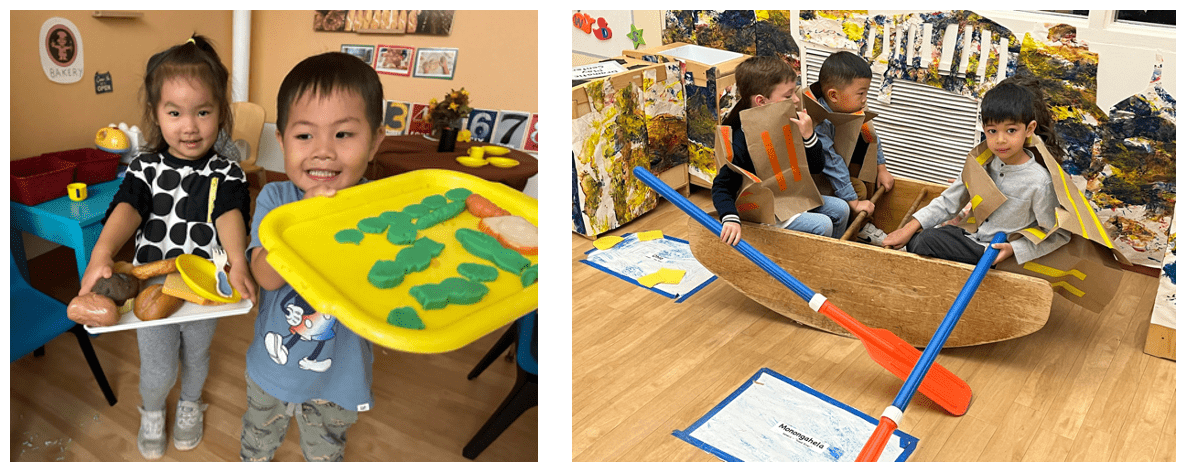
In many respects, young children can learn social skills as they develop self-esteem and independence – by exploration within a safe and encouraging environment. But, social learning theories also emphasize the importance of adults modeling appropriate interactions and acknowledging or reinforcing the behaviors that children need to practice in order to become effectively integrated into a family, a class, a team, etc. Sociocultural theories highlight the need for a supportive context where adults offer scaffolding to help ensure children’s successful participation. Cognitive information-processing theories, such as those guiding much of the research in Carnegie Mellon’s Psychology Department, stress the detailed specification of the knowledge and skills children need for each task and the explicit instruction and feedback relative to those specifications.
For these reasons, Children’s School educators 1) purposefully model respectful interactions with children, families, colleagues, undergraduates, researchers, and university personnel, 2) intentionally teach children the steps to take and words to use for both routine and challenging interactions, and 3) coach children through the process repeatedly until they can effectively interact on their own. We also embed directions, rules, and location cues within the environment with signs, visual schedules, photographs, etc., so children can successfully meet classroom expectations.
Within each theme, educators emphasize the necessary interactions and implications of cooperation. For example, the Preschool 3’s have been learning about the benefits of teamwork as farmers grow and harvest crops, like wheat, so communities have food. They practice teamwork in many ways, especially when it’s time to clean up after activity time! During the Preschool 4’s study of Pittsburgh, they have talked about the many helpers who keep our city a clean, safe, and fun place to live and play. Throughout the month, they have been introducing new “classroom jobs”, such as the pet helper who carefully feeds the fish just the right amount of food each day and the calendar helper who updates the day of the week during circle time. They’ve also practiced navigating small spaces and bulky props safely while playing in their Three Rivers boat area. After reading and discussing teamwork, the PreK/Kindergarten friends had a collaborative fun day last Friday. Each team got to complete a giant floor puzzle, do a collaborative drawing, build a zoo in the block area, and play a cooperative board game in which the players work together to beat the game.
Families can promote interaction and cooperation by using a similar mix of careful modeling, direct discussion of social expectations and strategies, and coaching in the context of natural interactions. Basic manners, social conventions for meeting and greeting people, and appropriate ways to make requests or handle disagreements are all important to practice at home and in the community. You can help children by reviewing in advance and adding just one new skill at a time. The successful interaction will provide its own reinforcement, particularly when others respond positively!

December 2023: Cultivating Communication
The Children’s School’s “developmental goals” for communication direct us to focus broadly on oral communication via listening & speaking as well as written communication via reading & writing – all in age appropriate ways, from the time children enter the school until they leave. By explaining our approaches to meeting these goals, I hope to show the purposes behind our practices so that families can be similarly intentional in supporting children’s increasingly effective communication.
Communication: facilitating comprehension and expression skills beginning with oral language (listening & speaking) and progressing to written language (reading & writing).

Children’s ability to learn oral language without direct instruction is amazing. Simple encouragement to participate in the naturally occurring conversations that are part of family and school life typically promotes appropriate developmental progressions, even with multiple languages being learned simultaneously, especially if children have exposure to effective models. I’m sure you’ve noticed, however, that children are just as capable of imitating the negative tone of voice and socially inappropriate words that they overhear, and that they usually do so at just the wrong time. That’s where consistently purposeful use of appropriate vocabulary, polite phrasing, and positive tones of voice, together with specific reinforcement, help children to use language for effective participation in varied social contexts. As with social skills, Children’s School educators use the triad of modeling, explicit instruction, and coaching to help individual children progress.
Developing skills for reading and writing surely benefits from the same approaches, but there are two key differences, both of which stem from the need to process many MORE bits of information, with lots of potentially confusing similarities (e.g., b vs. p vs. d vs. q or to vs. too vs. two) and exceptions (e.g., why do enough and stuff rhyme when cough and cuff do not?). Because of this heavy “cognitive load”, the learning process for most children takes an extended period of time and involves frequent, repeated errors. We cannot, therefore, expect the same rapid progress that is evident for oral language development. In order to support children’s motivation for tackling the written language challenges, we are extremely careful to encourage children’s efforts without emphasizing their mistakes. For these reasons, we focus on children’s communication of meaning rather than on conventional spelling, consistent letter sizing and orientation, etc. Research has shown that the key initial steps involve abilities to hear the separate sounds that together make words and then identifying the letter-sound correspondence. That’s why you hear us doing lots of activities with alliteration and rhyme. Within each theme, educators introduce new vocabulary and offer opportunities for children to utilize new terms when they converse about theme-related activities. We also utilize many visual representations of words, often together with relevant pictures, so that children begin to build sight word vocabulary and can easily find conventional spellings if they are interested. Surprisingly, practicing mathematics skills for patterns also helps children notice common features across words, such as bat, brat, hat, that, sat, splat, etc., or distinguish features for commonly confused words, such as where, wear, were, and whir. Families can promote both oral and written communication by encouraging children’s involvement in conversation, story reading, and writing for real purposes. Offer multiple options and follow your child’s interests along the way.

January 2024: Deepening Discovery & Exploration
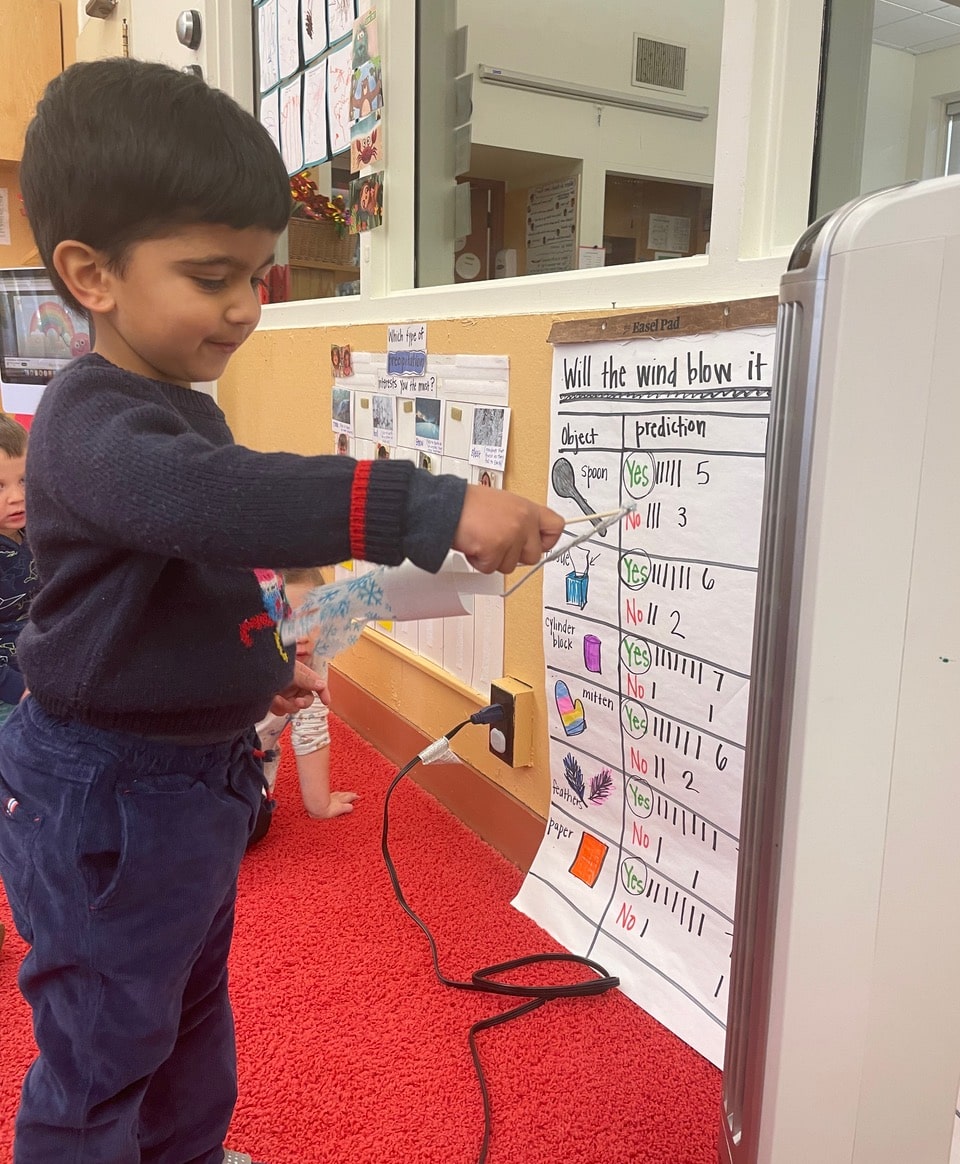 The Children’s School’s “developmental goals” for discovery & exploration express our commitment to substantive, inquiry-based study of developmentally appropriate themes. By highlighting our educators’ intentional preparation for these learning experiences and responsiveness to the children’s questions and interests, I seek to demonstrate ways that families can further enhance the children’s developing skills and knowledge foundations for future learning.
The Children’s School’s “developmental goals” for discovery & exploration express our commitment to substantive, inquiry-based study of developmentally appropriate themes. By highlighting our educators’ intentional preparation for these learning experiences and responsiveness to the children’s questions and interests, I seek to demonstrate ways that families can further enhance the children’s developing skills and knowledge foundations for future learning.
Discovery & Exploration: fostering a positive attitude toward learning through scientific and mathematical inquiry with varied materials to build strong concepts related to diverse themes.
Children’s “approaches to learning” are the most important focus of our intentional teaching during the early years. We foster curiosity, initiative, attention, concentration, planning, persistence, acceptance of mistakes as part of learning, and the value of multiple strategies and solutions to problems. As with the other developmental domains, we combine modeling, explicit instruction, and coaching throughout the inquiry process such as you see here with Preschool 3’s exploring what the “wind” from the fan will blow, the Preschool 4’s testing different ways to make orange juice from oranges, and the PreK / Kindergarten children experimenting with color mixing.

The specific skills we teach generally follow the scientific method, beginning with questioning and predicting, then collecting and observing, and finally explaining and reporting. When seeking answers to our questions, we teach classifying, ordering, and comparing and contrasting as basic skills that we practice with varied objects and events to highlight foundational science and math concepts. We also introduce a wide range of tools for observing and representations for recording so that children have multiple options at their disposal. When choosing themes, we aim for broad coverage of life, earth, and physical sciences, literature and the arts, and social studies topics, though most themes include key concepts from multiple disciplines.
Children’s School Themes for 2023-2024
| Subject Area | Preschool 3’s | Preschool 4’s | PreK/Kindergarten |
| Life Science | Harvest | Ocean | Healthy Mind & Body Biomes of the World |
| Earth Science | Weather | Our Earth | Space and Sky |
| Physical Science | Inventors & Inventions Building |
Inventors & Inventions | Inventors & Inventions |
| Literature | Author Study: Julie Flett | Storytelling | Poets and Poetry |
| Arts | Art & Color | Music & Musicians | Elements of Art |
| Social Studies | Games | Games Pittsburgh |
Ancient Egypt |
We’re ALL about to study Inventors & Inventions, which will include lots of focus on social studies and physical science, with elements of other subjects that are relevant to a particular invention. What amazes me most about our educators’ approach to the themes is their ability to identify the key concepts and frame them in a way that the children can understand. We also rely heavily on non-fiction books, internet sites with appropriate images and explanations, and expert guests to support our explanations of key theme content. Naturally, mathematics is a prominent part of our inquiry process because our data collection often involves counting, measuring, describing shapes, spatial relations and patterns, and then representing the data via graphs, tables, etc. Our upcoming Inventors & Inventions unit will have many opportunities for extended projects that involve design thinking with science and math concepts.
Family support for discovery and exploration is essential because you have more time to help each child pursue individual interests for even deeper inquiry, especially via extended projects, field trips, and broader reading / internet research. We look forward to hearing about your explorations and invite you to join ours during any of our units, but especially the upcoming Inventors & Inventions exploration!

February 2024: Facilitating Physical Capabilities
The Children’s School’s “developmental goals” for physical capabilities, including health and safety, focus our program design on offering diverse opportunities for children to strengthen their bodies while actively learning indoors and out. By emphasizing the ways we purposefully invite productive and creative movement in safe contexts, I aim to encourage families to collaborate with us to promote healthy and active lifestyles at home, at school, and in the community.
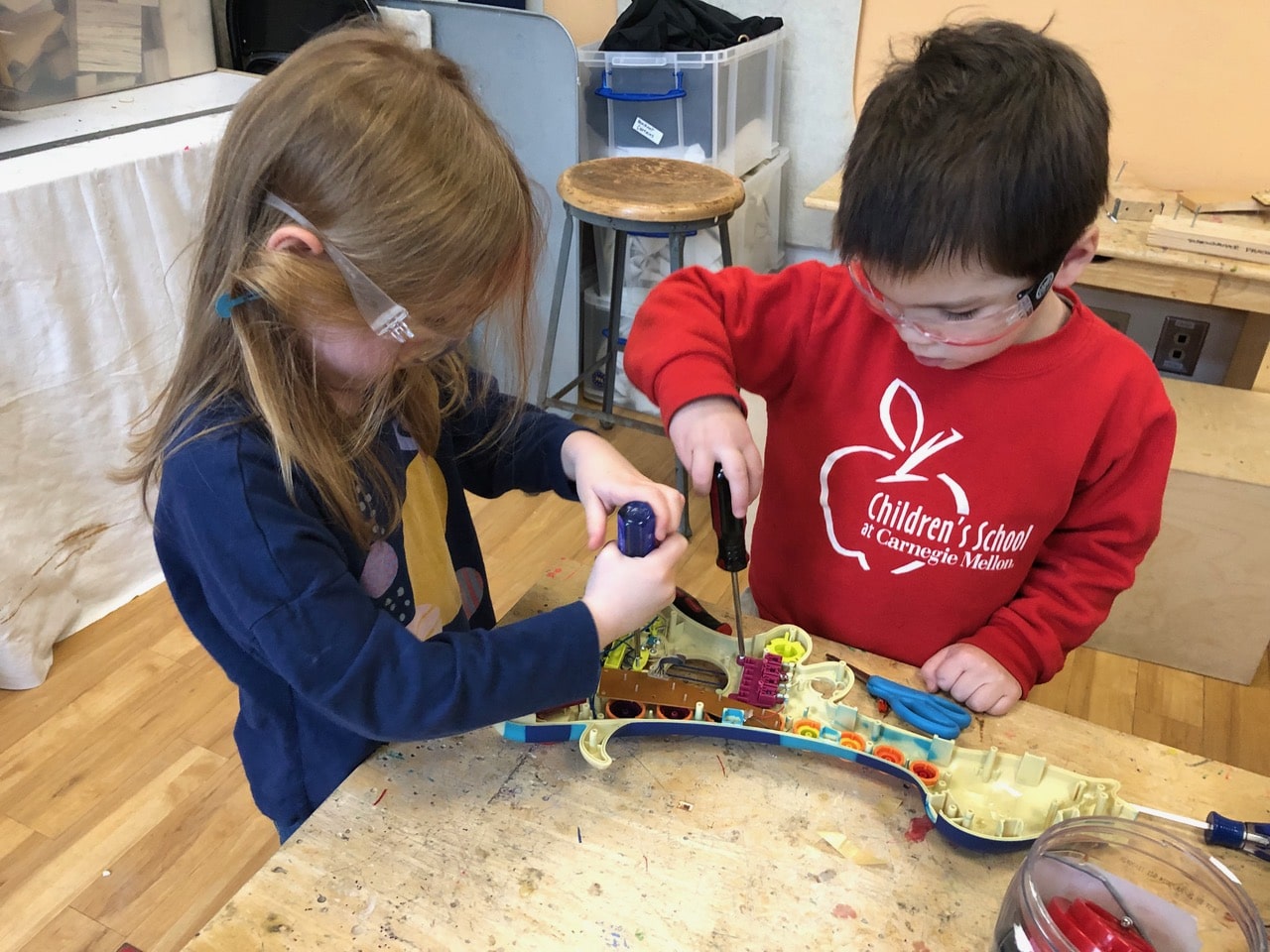
Physical Capabilities / Health & Safety - giving children opportunities to use their growing bodies to develop small and large motor skills, healthy living habits, and essential safety practices.
Our intentional planning for young children’s motor development includes both small (fine) and large(gross) motor skills. Small motor skill building includes offering a wide range of activities that require eye-hand coordination (e.g., puzzles, blocks, beads, pegs, etc.), use of tools for real tasks (e.g., drawing, writing, cutting, woodworking, cooking, weaving, etc.), and coordinated hand motions involving clapping, tracing, folding, etc. Large motor skill development includes strengthening leg & foot skills (e.g., balancing, walking, marching, running, hopping, etc.), arm & hand skills with varied balls (e.g., throwing, catching, rolling, bouncing, etc.), and coordinated movements of both arms & legs (e.g., riding a tricycle, pulling a wagon, climbing, jumping rope, doing yoga, etc.). For all movements, we aim for sufficient practice to increase coordination, strength, and body control. The specific concepts and skills that we teach about health and safety include nutritious food choices, effective hygiene habits, appropriate waste disposal and recycling, and consistent use of safety procedures and equipment (e.g., crossing the street, emergency drills, wearing safety goggles, etc.).
As with the other developmental domains, we combine modeling, explicit instruction, and coaching throughout the individualized process for each child, and we encourage initiative, attention, concentration, planning, persistence, acceptance of mistakes as part of learning, and the value of multiple strategies and solutions to movement problems. For every theme, we develop related activities in each of the learning centers so that children have novel materials, projects, games, and dramatic play opportunities to practice their developing skills while learning about the topic of study. Our upcoming whole school theme of Inventors & Inventions will involve strengthening small motor skills and eye-hand coordination through tool use, constructing inventions with a variety of materials, and practicing safety precautions such as wearing eye protection when in the Make Shop and following directions carefully when visiting campus invention labs.
You might be surprised to learn how much mathematical Discovery & Exploration is involved in movement. We count movements and arrange movements in patterns, particularly when rhythm and dance are involved. We can move our bodies to create shapes and explore ways to move in, out, under, over, and around our friends or objects in our environment. We can measure our movement frequency, speed, distance, etc. and graph these measurements to monitor our progress over time. There is also math involved in many of our health and safety practices, such as using the My Plate nutrition guide, washing our hands for a certain length of time, and sorting learning materials at clean up time.
Families can enhance everyone’s physical development by making active, healthy, and safe choices on a daily basis, as well as by discussing options with the children. Many household tasks involve exercising small and large muscles, so have fun cooking, cleaning, and doing yard work together!
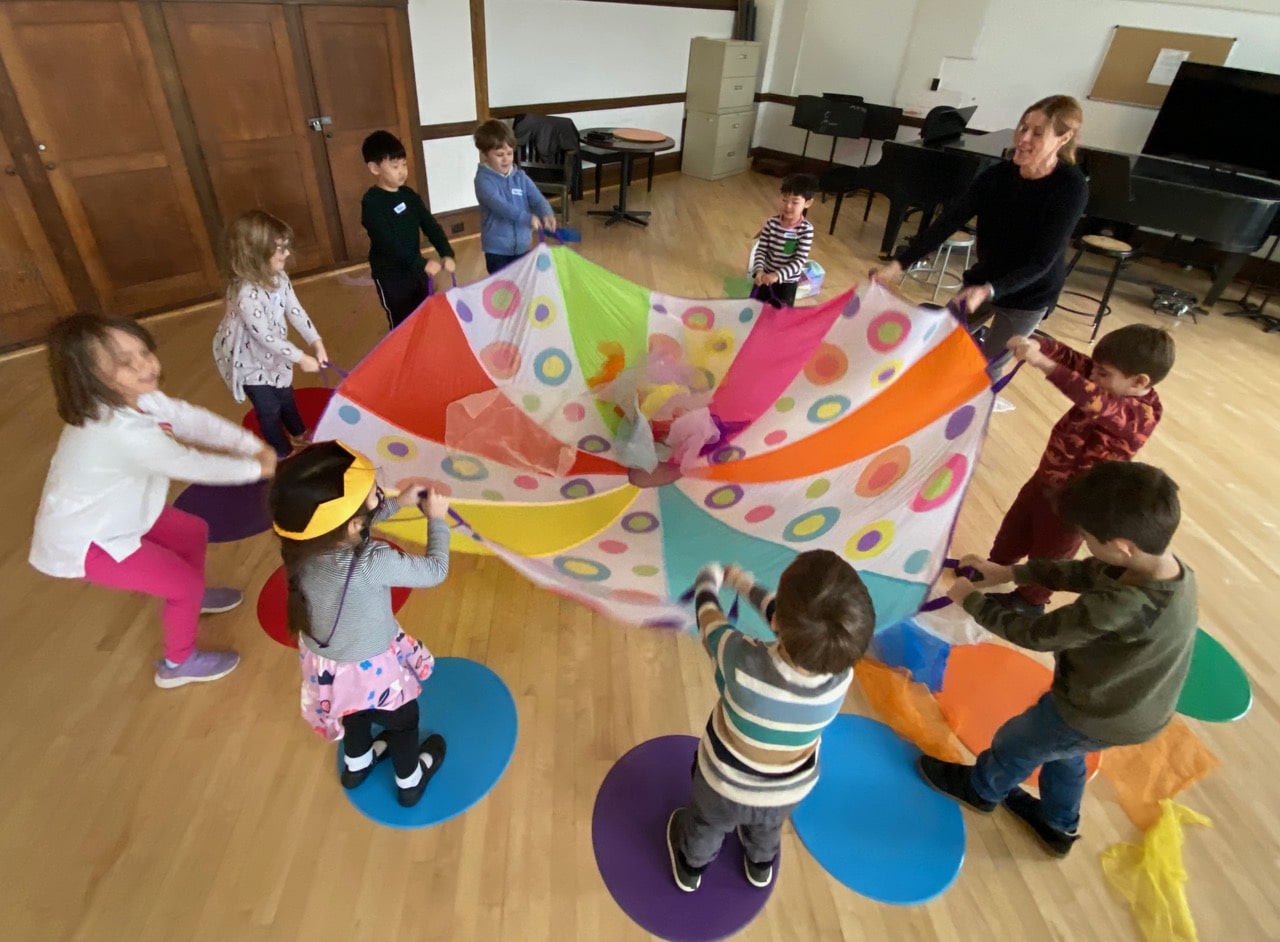
March 2024: Enhancing Artistic Expression & Appreciation

The Children’s School’s “developmental goals” for artistic expression and appreciation broaden our program design to invite children’s self-expression in ways that go beyond traditional verbal communication, as well as their respect for others’ self-expression. By highlighting our intentional integration of visual arts, music, creative movement, and drama into our program, I seek to promote family exploration of similar options as you interact with each other at home and in the community.
Artistic Expression & Appreciation - cultivating each child's ability to express ideas and emotions through art, drama, and music and movement, as well as to appreciate the artistic expressions of others.
Planning intentionally for any type of arts experience involves materials, tools & techniques, and opportunities. Young children need time to explore materials before they can productively utilize them to express their ideas, so we offer many chances for children to experiment with the same materials and to compare and contrast them. Learning how chalk works on paper vs. cement, with and without water, helps prepare a child for independent choices of artistic medium. Similarly, exploring sounds made with Mrs. Hraber’s diverse musical instruments and with the whale drum and chime wall in our outdoor classroom may eventually lead to their choice of instruments for future lessons. Teachers support children’s exploration by explicitly introducing new tools and specific production techniques. For example, in one recent lesson with small glockenspiels, Mrs. Hraber had the children try tapping each note distinctly while going up the scale and then sweeping the mallet from the top to bottom of the scale on the way down. We also share “tricks of the trade”, like making dramatic play props from light materials but using your actions to make them appear heavy. The rest of our design involves offering diverse opportunities to entice all of the children to engage in the arts. We aim for open-ended activities and responsiveness to children’s ideas for extending them.
Some of our themes emphasize the arts directly, such as prior whole school units on Art & Artists, Music, and Performing Arts. Others naturally promote dramatic play and theatrical production, such as the Preschool 4’s recent Storytelling unit and the PreK/Kindergarten’s upcoming unit on Ancient Egypt. Even units that might seem more science oriented, like Building or Art & Color, afford many opportunities for exploring and appreciating aesthetics and design. Regardless of the specific focus of study, our educators develop creative experiences to help the children understand the topic more fully and to share their ideas more broadly. We also recruit diverse artists to share their work with the children to foster appreciation and help children learn how to be a respectful audience and thoughtful critic. Our recent experience at the dress rehearsal for Professor Mead’s Baking Up Music performance was an incredible opportunity for our whole school to practice appreciating others’ talents.
Pittsburgh offers families many venues for arts exploration, starting with public art and free community performances, to open-ended arts spaces at the Children’s Museum, to formal arts classes for young children. Parents can also glean ideas for home experiences from the teachers’ daily emails and children’s suggestions. With imagination, a few basic supplies, and a space that can be easily cleaned, families can collaboratively create and entertain, both indoors and out. Taking photos of your experiences can help preserve the memories and encourage reflective discussion as well. Focusing more on the artistic process than the product will help everyone enjoy the magical moments along the way!
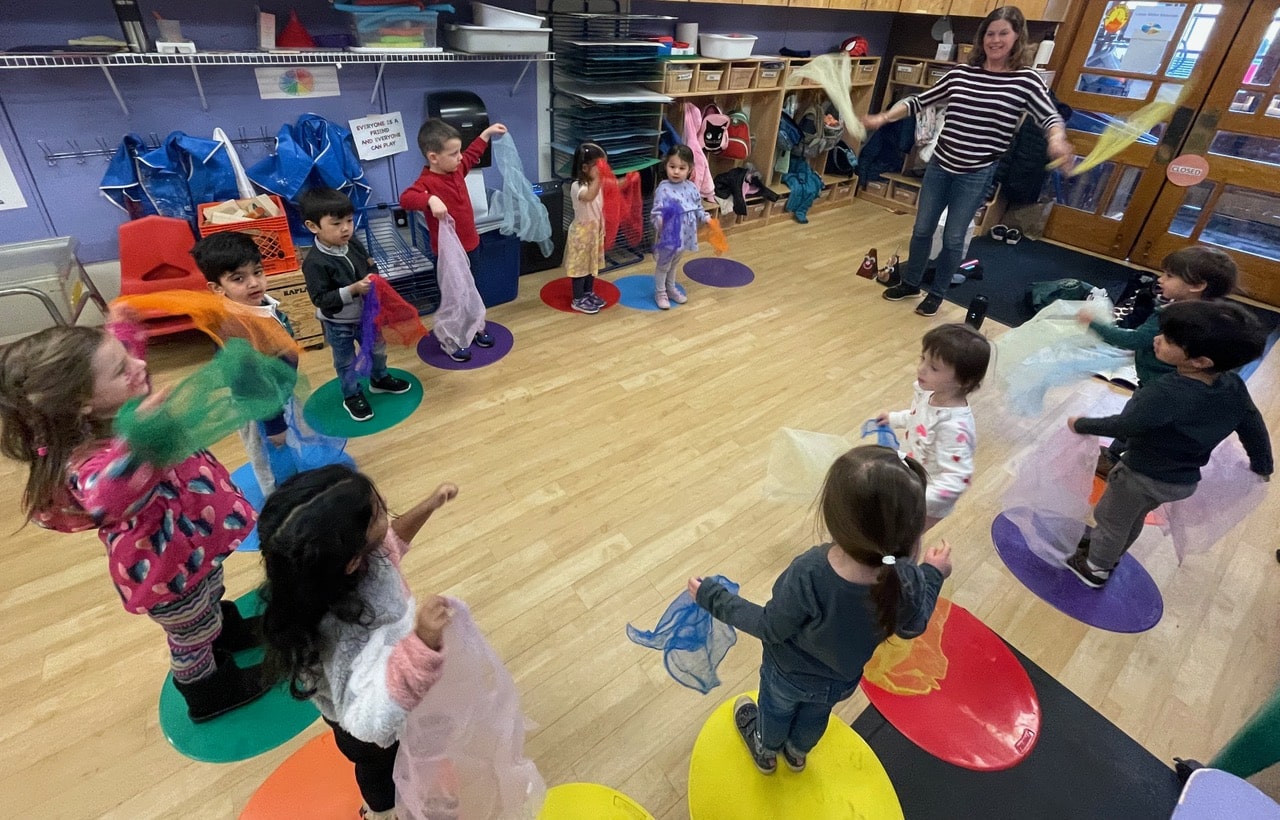
April 2024: Play as a Priority
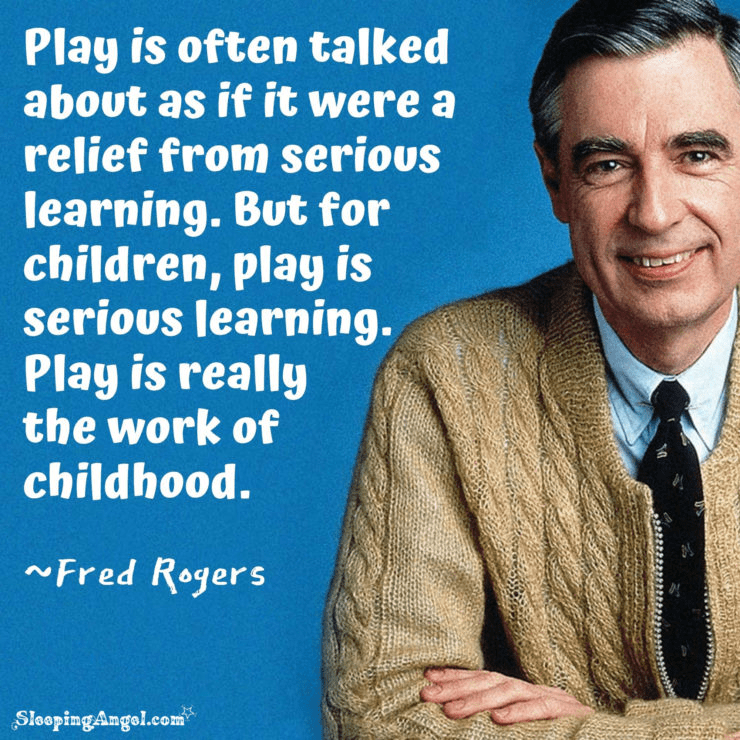
“Play is often talked about as if it were a relief from serious learning. But for children, play is serious learning. Play is really the work of childhood.” –Fred Rogers
Young children’s play has many benefits for all aspects of development. At the Children’s School, educators support children’s play as a significant means to engage them in effective learning in all six of our developmental domains.
Self-Esteem & Independence
Play contexts invite children to express their own ideas and understanding while they explore and master new materials. Children thrive when they have a choice of meaningful activities and open-ended options for using a variety of materials. Such choices invite children to take initiative in their own learning and foster intrinsic motivation – the desire to work on a task primarily because it is satisfying.
Interaction & Cooperation
Children play in diverse ways. They engage in “solitary play” apart from others or in “parallel play” near other children who are using the same materials but engrossed in their own activity. Interaction begins with “associative play”, which involves some conversation, sharing of materials, and similar actions but no coordination of goals. True “cooperative play” emerges as children begin to develop shared goals, such as a coordinated scenario in the dramatic play area, a joint building endeavor in the block area, or a team game on the playground. The more children play together, the better they understand other children’s points of view, demonstrate empathy and caring, and develop conflict resolution skills.
Communication
As children interact during play, they learn to use language in new ways to describe their play, negotiate sharing, plan joint goals, etc. Their vocabulary increases as they learn words for new objects and actions in our changing theme-related centers (e.g., the “Space Station” in the Preschool 4’s Our Earth unit or the “Ancient Egyptian Marketplace” in the PreK / Kindergarten Ancient Egypt unit).
Discovery & Exploration
Children’s indoor and outdoor play provides many opportunities for developing and testing theories about how things work in the world. Sand, water, light, and block play enhance children’s understanding of physical realities of everyday materials. Changing materials in the centers as new themes are introduced provides frequent catalysts for new experiments, or inventions like in our recent whole school unit on Inventors and Inventions.
Physical Capabilities / Health & Safety
During play, children’s whole bodies are engaged in learning, which builds both small and large motor skills naturally. Children learn what is safe and risky as they stretch their physical prowess and build coordination and stamina.
Artistic Expression & Appreciation
Dramatic play, art and writing center explorations, and other music and movement opportunities offer children a variety of media for expressing their ideas and learning to appreciate others’. These experiences build skills in each of the other domains as well, thus expanding children’s learning via play.
Parents can support play in many of the same ways that we do at school, by providing space, opportunities, and materials, as well as arranging “playdates” with peers and visiting public play areas where children can interact with groups of different age children. Space where children can play without fear of damaging furniture or injuring themselves, time to choose and become engaged in their own play activities, and simple, interesting materials are key ingredients. Feel free to come observe play at the Children’s School and to share your ideas with us.
May 2024: Summer Learning Opportunities

Though the school year is ending, opportunities for children to learn and parents to facilitate development are plentiful, particularly in the summer months. Here are a few ideas to help you think about simple ways to promote children’s growth in each of the key domains of development.
Self-Esteem and Independence
- Since the pace of summer is typically slower, allow time for children to do as much as possible for themselves. The resulting increase in independence will promote self-esteem AND help prepare the child for new responsibilities at school next year.
- Sharing experiences and ideas provides an opportunity for children to discover the value of their contributions. Allow time for leisurely conversation while sipping lemonade or taking a walk. Invite the child to suggest activities for the day, ways to celebrate a special event, or items to pack for a picnic lunch.
Interaction and Cooperation
- Summer often brings more time with extended family and friends, which encourages important social interactions. The longer days and special activities, on the other hand, often change sleep schedules and other important routines. While it is essential to learn flexibility, you’ll find that children are best able to cope with the necessary changes when they get enough rest and enjoy the comfort of consistency. Your efforts in this area will make all of the suggestions below more successful.
- Interacting siblings, cousins, playground partners, etc. all provide opportunities to practice taking other perspectives and negotiating. These valuable skills can be learned best when adults help children to think in advance about situations that might arise. Anticipating another child’s interests, planning to choose one activity the child likes and one the peer likes, and considering ways to handle a sibling’s refusal all help the child respond more appropriately when the time comes.
Communication
- Extra car time during summer travel is wonderful for word games and songs. Remember that oral communication is the foundation for written communication.
- Read a book. Read it again. Consider alternate endings. Write and illustrate your own version.
- Get doubles of photos from family outings and travel so that the children can have some from the extra set. Consider making a summer photo journal with the child choosing the photos and dictating or writing the captions themselves.
- Choosing and preparing postcards for mailing to family and friends is another great way to promote meaningful writing skills.
Discovery and Exploration
- Ask questions that promote thinking about how and why things happen the way they do. Use “I wonder …” and respond to questions with “What do you think?” The local library is a wonderful source for children’s non-fiction books for help in discovering answers.
- Choose a sunny space at home for observations and collections. Grow a plant, collect pebbles, or keep a pet bug for a while. It’s helpful to have a magnifying glass, trays for sorting, and a clipboard with paper and colored pencils for recording observations.
Physical Capabilities
- Many of the ideas listed above include fine and gross motor practice.
- Helping with family chores both indoors and outdoors can also strengthen physical skills (as well as independence, which fosters self-esteem). Invite children to help with the gardening, laundry, table setting, dishes, etc.
- Remember that children need to practice every skill repeatedly to develop effective coordination and build strength. Creating an obstacle course or developing “carnival” games are fun ways to encourage repetition.
Artistic Expression and Appreciation
- Notice and draw attention to art EVERYWHERE! The shapes and patterns in nature offer intricate examples. Designs on posters, buildings, bridges, etc. can inspire children’s own creations. Notice sounds and movements as well, since they are part of music, dance, and drama.
- Provide a wide variety of open-ended materials for art, dramatic play, creative movement, and exploration of sound. Collage materials in an “invention box” with lots of glue can yield hours of fun. Simple scarves or pieces of interesting cloth can become a hundred costumes or parts of interesting forts.
Best wishes for a safe and relaxing summer! We encourage you to share your experiences with us via postcards, journals, photos, etc. and look forward to welcoming many of you back in the fall. For those of you making transitions to other schools, good luck and please keep in touch. You’ll always be part of the Children’s School family.
